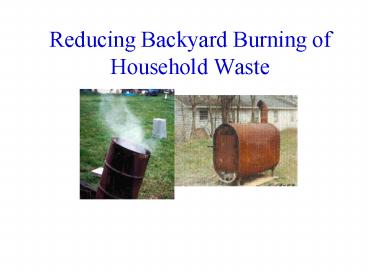Reducing Backyard Burning of Household Waste PowerPoint PPT Presentation
1 / 20
Title: Reducing Backyard Burning of Household Waste
1
Reducing Backyard Burning of Household Waste
2
What is Backyard Burning?
- Backyard burning (BYB) is the uncontrolled
combustion of household waste in barrels, open
pits, wood stoves, or fireplaces.
- (also known as burn barrels, open burning, or
household trash burning)
3
Why are we Concerned?
Some consider this an issue of the past.
But in reality, this is often a common practice
in less urban areas of the U.S.
4
Why are we Concerned?
- Backyard burning causes accidental fires.
- Backyard burning releases toxic chemicals into
environment that can cause adverse health
impacts. - Backyard burning is illegal in
many places.
5
Release of Toxic Chemicals
Direct Exposure (e.g. inhalation)
- Particulate Matter
- Sulfur Dioxide
- Carbon Monoxide
- PAHs
- Metals
- Hexacholorobenzene
- Dioxin
Indirect Exposure (e.g. bioaccumulation)
6
Direct Exposure Health Effects
- Eye and lung irritant
- Asthma trigger
- Emphysema
- Other respiratory diseases
7
Indirect Exposure Health Effects
- Reproduction and development effects
- Endocrine Disruption
- Immunosuppression
- Cancer
8
What are Dioxin-like Chemicals?
- A group of chlorinated organic compounds
including dioxins, furans, and some PCBs. - Produced when most materials are burned.
- Occur from incomplete combustion of fuels or
waste, some chemical manufacturing, and high
temperature metrological processes. Includes
some natural sources (e.g. forest fires).
9
Dioxin-like Chemicals
- Dioxins are a group of chemicals that are potent
animal toxicants and likely human carcinogens. - There are 30 different Dioxin-like compounds.
- 2,3,7,8 TCDD is the most studied of the chemical
class. - USHHS and IARC classify 2,3,7,8 TCDD as a human
carcinogen.
10
Why are Dioxins a Problem?
- Persist in the environment.
- Shown to be highly toxic in animal and human
studies even at extremely low levels. - Effect reproduction development, suppress the
immune system, and can cause cancer. - Bioaccumulative and remain in the body for a long
period of time. - Principal route of exposure is via food intake.
11
Adult Average Daily Intake of CDDs/CDFs/Dioxin-lik
e PCBs
2000 Draft Estimate 65 pg TEQDFP-WHO98/day
12
Evolving Dioxin Science
- The Good News
- The average bioaccumulation level in humans has
dropped from 55 ppt (in the 1980s) to 25 ppt
(1990s) - The Bad News
- The level at which health effects are detectable
in animals and humans is lower than previously
estimated. Consequently, current exposures
remain a concern. - The Bottom Line
- We need to take steps to further reduce dioxin
exposure.
13
BYB Emissions are Greater Than All Other
Quantified Sources Combined
All other
sources
BYB
14
The BYB concern is not just releases, but also
exposure...
Most BYB occurs in rural areas where emissions
can readily contribute to contamination of animal
feed and grazing lands.
15
Sources and Pathways to Human Exposures
16
Why is Backyard Burning a Priority?
- BYB is the largest remaining quantified source of
dioxin emissions. - BYB used by an estimated 20 million Americans.
- Proximity to animal feed and food crop production
increases concern. - Reducing BYB also reduces other toxic releases
including metals, PAHs, and particulate matter. - Reducing BYB will reduce accidental fires.
17
Three Tiered Approach Education,
Infrastructure, and Compliance
- Educate government officials and the general
public on the concerns of BYB. - Provide information on infrastructure and
alternatives to BYB in rural areas. - Strengthen state, tribal, and local ordinances on
BYB. Support greater compliance with existing
regulations.
18
Current Activities at the Federal Level
- Develop quality public information material that
could be used by states, tribes, and localities
to educate public officials and the general
public about the detrimental consequences of BYB.
- Develop and disseminate information on
strengthening rural waste management
infrastructure so that it can provide
constructive alternatives to BYB. - Provide information to states, tribes and
localities on legislation and enforcement
programs so that interested governments can learn
from the successful efforts of others.
19
What Can YOU Do?
- Share the message
- Identify other waste disposal methods in your
community - Reduce (avoid disposable items)
- Reuse (more use means less waste)
- Recycle (paper, plastics, metallic items)
- Compost (leaves, yard waste, vegetable wastes)
- Identify local landfills which accept waste
20
Where Can You Get More Information?
- Information on the national program,
- links to local programs, and other
- resources may be found on line at
- www.epa.gov/msw/backyard

